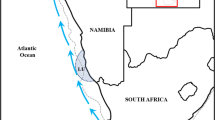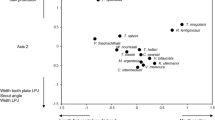Abstract
In many vertebrate radiations, food partitioning among closely related taxa is a key factor in both the maintenance of species diversity and the process of diversification. We compared diet composition and jaw morphology of 18 New Zealand triplefin species (F. Tripterygiidae) to examine whether species have diversified along a trophic axis. These fishes predominantly utilised small, mobile benthic invertebrates, and interspecific differences in diet composition appeared to be mainly attributable to habitat- or size-dependent feeding behaviour. Although there were differences in the relative size of the bones comprising the oral jaw apparatus between species, the majority showed an apparatus consistent with a relatively high velocity, low force jaw movement indicative of a diet of evasive prey. Phylogenetic comparative analyses showed that the evolution of jaw lever ratios and diet breadth was best explained by a non-directional model in which character changes have occurred randomly and independent of phylogeny. The mode of diet breadth evolution was gradual and the tempo has not accelerated or slowed down over time. The mode of evolution for the jaw lever ratios has been gradual for the opening but punctuated for the closing levers, suggesting that evolutionary changes have occurred rapidly for the latter trait. The tempo of trait evolution for the jaw opening levers has not accelerated or slowed down over time, while the tempo for the jaw closing levers has accelerated towards the tips of the tree, which is suggestive of species level adaptation. The lack of phylogenetic signal in diet breadth and jaw lever ratios appears most likely to be a correlated response to the marked habitat diversification in this group, and is thus the passive outcome of prey availability in species-specific habitat types. Overall, the trophic ecology of New Zealand’s triplefin fauna parallels the generalist strategy typical of the family worldwide, suggesting that trophic resource partitioning has not been an important factor in the evolution of these fishes.






Similar content being viewed by others
References
Albertson RC, Streelman JT, Kocher TD, Yelick PC (2005) Integration and evolution of the cichlid mandible: the molecular basis of alternate feeding strategies. Proc Natl Acad Sci USA 102:16287–16292
Anderson MJ, Millar RB (2004) Spatial variation and effects of habitat on temperate reef fish assemblages in northeastern New Zealand. J Exp Mar Biol Ecol 305:191–221
Angel A, Ojeda FP (2001) Structure and trophic organization of subtidal fish assemblages on the northern Chilean coast: the effect of habitat complexity. Mar Ecol Prog Ser 217:81–91
Bellwood DR, Wainwright PC (2002) The history and biogeography of fishes on coral reefs. In: Sale PF (ed) Coral reef fishes. Dynamics and diversity in a complex ecosystem. Academic Press, San Diego, pp 5–32
Beyst B, Vanaverbeke J, Vincz M, Mees J (2002) Tidal and diurnal periodicity in macrocrustaceans and demersal fish on an exposed sandy beach, with special emphasis on juvenile plaice Pleuronectes platessa. Mar Ecol Prog Ser 225:263–274
Boyle KS, Horn MH (2006) Comparison of feeding guild structure and ecomorphology of intertidal fish assemblages from central California and central Chile. Mar Ecol Prog Ser 319:65–84
Carr MH, Anderson TW, Hixon MA (2002) Biodiversity, population regulation, and the stability of coral-reef fish communities. Proc Natl Acad Sci USA 99:11241–11245
Castillo-Rivera M, Kobelkowsky A, Zamayoa V (1996) Food resource partitioning and trophic morphology of Brevoortia gunteri and B. patronus. J Fish Biol 49:1102–1111
Clarke KR, Warwick RM (1994) Change in marine communities: an approach to statistical analysis and interpretation. Plymouth Marine Laboratory, Plymouth
Clements KD (2003) Triplefins. In: Andrew NL, Francis MP (eds) The living reef. The ecology of New Zealand’s rocky reefs. Craig Potton Publishing, Nelson, pp 160–167
Clements KD, Jawad LA, Stewart AL (2000) The New Zealand triplefin Forsterygion signata (Teleostei; Tripterygiidae): a junior synonym of G. gymnota from Tasmania. J R Soc NZ 30:373–384
Denoeel M, Schabetsberger R (2003) Resource partitioning in two heterochronic populations of Greek Alpine newts, Triturus alpestris veluchiensis. Acta Oecol 24:55–64
Duftner N, Koblmueller S, Sturmbauer C (2005) Evolutionary relationships of the Limnochromini, a tribe of benthic deepwater cichlid fish endemic to Lake Tanganyika, East Africa. J Mol Evol 60:277–289
Eastman JT (1997) Phyletic divergence and specialization for pelagic life in the antarctic Nototheniid fish Pleuragramma antarcticum. Comp Biochem Physiol A Mol Integr Physiol 118:1095–1101
Feary DA, Clements KD (2006) Habitat use by triplefin species (Tripterygiidae) on rocky reefs in New Zealand. J Fish Biol 69:1031–1046
Floeter SR, Ferreira CEL, Dominici-Arosemena A, Zalmon IR (2004) Latitudinal gradients in Atlantic reef fish communities: trophic structure and spatial use patterns. J Fish Biol 64:1680–1699
Fricke R (1994) Tripterygiid fishes of Australia, New Zealand and the Southwest Pacific Ocean (Teleostei). Koeltz Scientific Books, Königstein
Fricke R (1997) Tripterygiid fishes of the western and central Pacific, with descriptions of 15 new species, including an annotated checklist of world Tripterygiidae (Teleostei). Koeltz Scientific Books, Königstein
Fricke R (2002) Tripterygiid fishes of New Caledonia, with zoogeographical remarks. Environ Biol Fish 65:175–198
Futuyma DJ, Moreno G (1988) The evolution of ecological specialization. Annu Rev Ecol Syst 19:207–233
Glasby TM, Kingsford MJ (1994) Atypichthys strigatus (Pisces: Scorpididae): an opportunistic planktivore that responds to benthic disturbances and cleans other fishes. Aust J Ecol 19:385–394
Grossman GD (1986) Food resource partitioning in a rocky intertidal fish assemblage. J Zool Soc Lond B 1:317–355
Hickey AJR, Clements KD (2003) Key metabolic enzymes and muscle structure in triplefin fishes (Tripterygiidae): a phylogenetic comparison. J Comp Physiol B 173:113–123
Hickey AJR, Clements KD (2005) Genome size evolution in New Zealand triplefin fishes. J Heredity 96:356–362
Hickey AJR, Lavery SD, Eyton SR, Clements KD (2004) Verifying invasive marine fish species using molecular techniques: a model example using triplefin fishes (Family: Tripterygiidae). NZ J Mar Freshwat Res 38:439–446
Hilton Z, Wellenreuther M, Clements KD (2008) Physiology underpins habitat partitioning in a sympatric sister-species pair of intertidal fishes. Funct Ecol 22:1108–1117
Huelsenbeck JP, Ronquist F (2001) MRBAYES: Bayesian inference of phylogenetic trees. Bioinformatics 17:754–755
Hyndes GA, Platell ME, Potter IC (1997) Relationships between diet and body size, mouth morphology, habitat and movements of six sillaginid species in coastal waters: implications for resource partitioning. Mar Biol 128:585–598
Karpouzi VS, Stergiou KI (2003) The relationships between mouth size and shape and body length for 18 species of marine fishes and their trophic implications. J Fish Biol 62:1353–1365
Kotrschal K (1988) Evolutionary patterns in tropical marine reef fish feeding. Z zool Syst Evolut -forsch 26:51–64
Kotrschal K, Thomson DA (1986) Feeding patterns in eastern Tropical Pacific blennioid fishes (Teleostei: Tripterygiidae, Labrisomidae, Chaenopsidae, Blenniidae). Oecologia 70:367–378
Krebs CJ (1999) Ecological methodology. Benjamin/Cummings, California
Levesque C, Juniper SK, Marcus J (2003) Food resource partitioning and competition among alvinellid polychaetes of Juan de Fuca Ridge hydrothermal vents. Mar Ecol Prog Ser 246:173–182
Liem KF (1990) Aquatic versus terrestrial feeding modes: possible impacts on the trophic ecology of vertebrates. Am Zool 30:209–221
Longnecker K (2007) Devil in the details: high-resolution dietary analysis contradicts a basic assumption of reef-fish diversity models. Copeia 3:543–555
Matic-Skoko S, Antolic B, Kraljevic M (2004) Ontogenetic and seasonal feeding habits of the annular seabream (Diplodus annularis L.) in Zostera sp. beds, eastern Adriatic Sea. J Appl Ichthyol 20:376–381
Motta PJ (1985) Functional morphology of the head of Hawaiian and mid-Pacific butterfly-fishes (Perciformes, Chaetodontidae). Environ Biol Fish 13:253–276
Pagel M, Meade A (2004) A phylogenetic mixture model for detecting pattern-heterogeneity in gene sequence or character-state data. Syst Biol 53:571–581
Pagel M, Meade A, Barker D (2004) Bayesian estimation of ancestral character states on phylogenies. Syst Biol 53:673–684
Paulin CD, Roberts CD (1992) The rockpool fishes of New Zealand. Museum of New Zealand, Te Papa, Tongarewa, Wellington
Platell ME, Potter IC (2001) Partitioning of food resources amongst 18 abundant benthic carnivorous fish species in marine waters on the lower west coast of Australia. J Exp Mar Biol Ecol 261:31–54
Platell ME, Orr PA, Potter IC (2006) Inter- and intraspecific partitioning of food resources by six large and abundant fish species in a seasonally open estuary. J Fish Biol 69:243–262
Ronquist F, Huelsenbeck JP (2003) MrBayes 3: Bayesian phylogenetic inference under mixed models. Bioinformatics 19:1572–1574
Ross ST (1986) Resource partitioning in fish assemblages: a review of field studies. Copeia 2:352–388
Russell BC (1983) The food and feeding habits of rocky reef fish of northeastern New Zealand. NZ J Mar Freshw Res 17:121–145
Sale PF (2002) Coral reef fishes: dynamics and diversity in a complex ecosystem. Academic Press, Amsterdam
Schluter D (2000) The ecology of adaptive radiations. Oxford University Press, Oxford
Silberschneider V, Booth DJ (2001) Resource use by Enneapterygius rufopileus and other rockpool fishes. Environ Biol Fish 61:195–204
Streelman JT, Danley PD (2003) The stages of vertebrate evolutionary radiation. Trends Ecol Evol 18:126–131
Syms C (1995) Multi-scale analysis of habitat association in a guild of blennioid fishes. Mar Ecol Prog Ser 125:31–43
Taylor RB (1998) Density, biomass and productivity of animals in four subtidal rocky reef habitats: the importance of small mobile invertebrates. Mar Ecol Prog Ser 172:37–51
Vanderklift MA, Kendrick GA, Smit AJ (2006) Differences in trophic position among sympatric sea urchin species. Est Coast Shelf Sci 66:291–297
Wainwright PC, Richard BA (1995) Predicting patterns of prey use from morphology of fishes. Environ Biol Fish 44:97–113
Wellenreuther M (2006) Ecological factors associated with speciation in New Zealand triplefin fishes (Tripterygiidae). PhD. School of Biological Sciences, Auckland
Wellenreuther M, Barrett PT, Clements KD (2007) Ecological diversification in habitat use by subtidal triplefin fishes (Tripterygiidae). Mar Ecol Prog Ser 330:235–246
Wellenreuther M, Syms C, Clements KD (2008) Consistent habitat use across biogeographic gradients. Ecography 31:84–94
Wennhage H, Pihl L (2002) Fish feeding guilds in shallow rocky and soft bottom areas on the Swedish west coast. J Fish Biol 61:207–228
Westneat MW (1994) Transmission of force and velocity in the feeding mechanisms of labrid fishes (Teleostei, Perciformes). Zoomorphology 114:103–118
Westneat MW, Alfaro ME, Wainwright PC, Bellwood DR, Grubich JR, Fessler JL, Clements KD, Smith LL (2005) Local phylogenetic divergence and global evolutionary convergence of skull function in reef fishes of the family Labridae. Proc R Soc B 272:993–1000
Zekeria ZA, Dawit Y, Ghebremedhin S, Naser M, Videler JJ (2002) Resource partitioning among four butterflyfish species in the Red Sea. Mar Freshw Res 53:163–168
Acknowledgments
We thank L. Jawad, R. Baker, G. Almany and two anonymous reviewers for providing helpful comments, B. Creese and J. Grieve for taxonomic assistance, M. Westneat for advice on jaw levers, and A. Stewart and D. Neale for providing triplefin samples. This study was funded by a Marsden grant to K.D. Clements.
Author information
Authors and Affiliations
Corresponding author
Additional information
Communicated by S. A. Poulet.
Electronic supplementary material
Below is the link to the electronic supplementary material.
Rights and permissions
About this article
Cite this article
Feary, D.A., Wellenreuther, M. & Clements, K.D. Trophic ecology of New Zealand triplefin fishes (Family Tripterygiidae). Mar Biol 156, 1703–1714 (2009). https://doi.org/10.1007/s00227-009-1205-2
Received:
Accepted:
Published:
Issue Date:
DOI: https://doi.org/10.1007/s00227-009-1205-2




